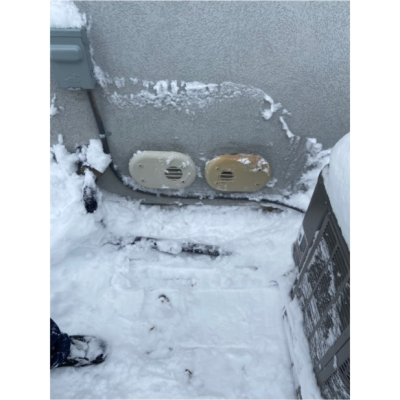Urgent Caution for Carbon Monoxide Poisoning

News Release Date: 02-27-2023
Unified Fire crews, especially in areas with newer construction, have been responding to multiple CO alarms over the last few days. Instead of venting from the roof, many newer homes with basements have appliance vents near the ground (pic below). Snow drifts/banks have reached up to four feet in some areas, covering these vent outlets and forcing the CO interior. Information Outreach has done a fair share of interviews as this issue appears unique to this 20-year storm. Below are some of the talking points we've shared with the media. Please feel free to continue educating our communities as you see fit.
Issue with snow buildup:
Snow covering appliance vents in homes can be dangerous for a few reasons:
Carbon Monoxide Poisoning: When vents for gas-powered appliances such as furnaces, water heaters, or stoves get covered by snow, it can cause the dangerous gas, carbon monoxide, to build up in the home. Carbon monoxide is a colorless, odorless gas that can cause headaches, nausea, and in severe cases, can be fatal.
Fire Hazard: If the snow covers the vents of electrical appliances like dryers or furnaces, it can cause them to overheat and pose a fire hazard. This is because the appliances can't get the necessary airflow to cool down.
Reduced Efficiency: Snow-covered vents can reduce the efficiency of appliances, which can increase energy costs and cause the appliance to work harder than necessary. This can lead to premature wear and tear, requiring costly repairs or replacement.
To prevent these dangers, it's important to keep appliance vents clear of snow and other debris. Homeowners can do this by regularly checking their vents and clearing any obstructions. If snow or ice is a recurring problem, installing vent covers or shields can help protect appliances and keep them running efficiently. It's also a good idea to have your appliances inspected and maintained regularly by a licensed professional.
Signs/Symptoms:
Carbon monoxide (CO) poisoning is a serious and potentially deadly condition that can be difficult to detect because the gas is colorless, odorless, and tasteless. Some of the signs and symptoms of CO poisoning can include:
- Headache
- Dizziness or lightheadedness
- Nausea or vomiting
- Shortness of breath or difficulty breathing
- Confusion or disorientation
- Blurred vision
- Loss of consciousness
- Chest pain
- Seizures or convulsions
- Weakness or fatigue
The severity of symptoms can vary depending on the level and duration of exposure to carbon monoxide. It's important to seek medical attention if you suspect that you or someone else may have been exposed to CO. If you suspect CO poisoning, you should immediately move to a well-ventilated area and call 911 or your local emergency services. It's also important to have working CO detectors in your home, as they can alert you to the presence of the gas and give you time to evacuate the area.
Annual CO Poisoning Rates:
According to the Centers for Disease Control and Prevention (CDC), there were an average of 430 carbon monoxide (CO) related deaths per year in the United States between 2010 and 2019. These deaths were primarily caused by unintentional CO poisoning, which can occur when fuel-burning appliances or equipment are not working correctly or are not properly ventilated. In addition to these fatalities, there were also an estimated 50,000 emergency department visits each year due to CO poisoning. It's important to have working CO detectors in your home, as well as to ensure that fuel-burning appliances are properly installed, vented, and maintained.
CO Detector Placement:
Carbon monoxide detectors should be placed in the home in areas where people spend the most time, such as near sleeping areas and living spaces. Here are some specific guidelines on where to place carbon monoxide detectors in your home:
Near Sleeping Areas: It's recommended to install a carbon monoxide detector in each bedroom or within 10 feet of the door to the bedroom. This is important because people are most vulnerable to CO poisoning when they are sleeping, and the symptoms of CO poisoning can be mistaken for other conditions.
Living Areas: Install a detector in or near any living areas where people spend a lot of time, such as the family room, den, or playroom.
Near Combustion Appliances: Install a detector in any room with a gas or fuel-burning appliance, such as a furnace, water heater, or stove.
Basements: If your home has a basement, install a detector at the top of the stairs leading to the basement.
It's important to read and follow the manufacturer's instructions for your specific carbon monoxide detector, as they may have specific recommendations on where to install the device. Also, make sure to test your detectors regularly and replace batteries as needed. Finally, if your detector sounds an alarm, leave the house immediately and call 911 or your local emergency services.
